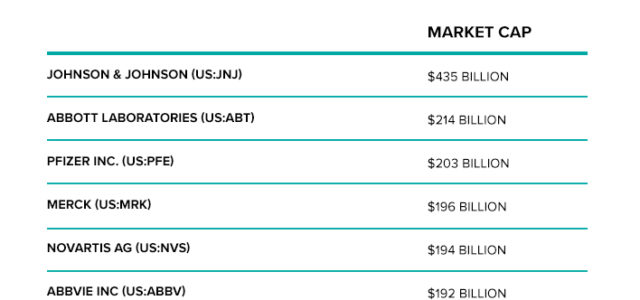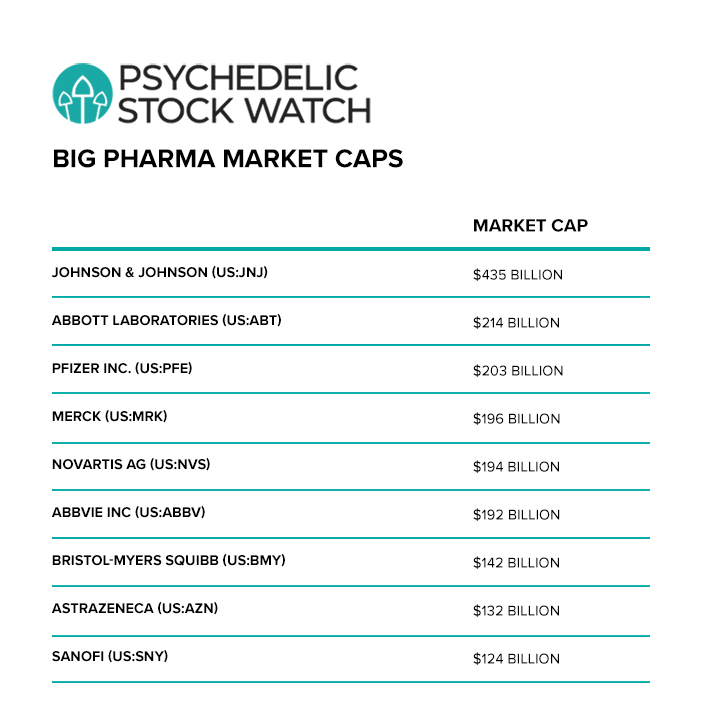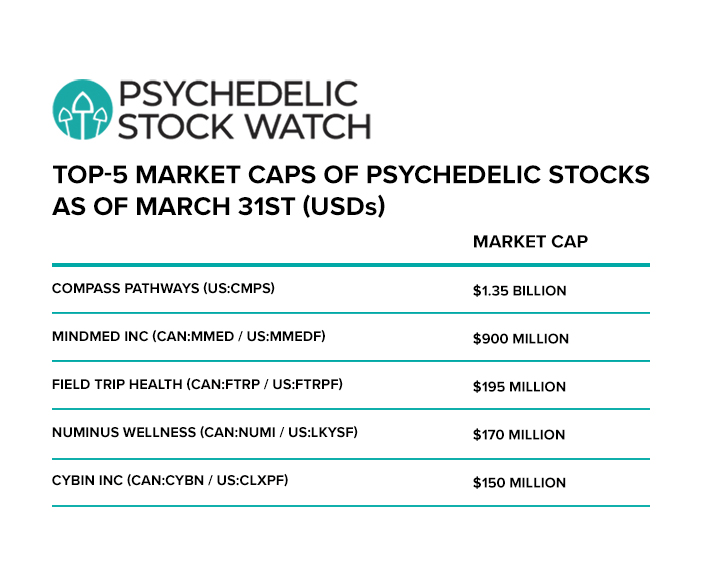Hard Numbers On The Huge Potential Of Psychedelic Drug Development
Marijuana Stocks, Finance, & InvestingUncategorized April 5, 2021 MJ Shareholders

- Psychedelic drug R&D is producing next-generation medical solutions for an ever-growing list of mental health disorders and other medical conditions
- Many of the largest medical treatment markets are currently being targeted
- Potential revenue streams for these markets range from billions to 100s of billions of dollars per year
With many psychedelic stocks having slipped into deep troughs, Psychedelic Stock Watch has been highlighting how “cheap” these pubcos have gotten.
We’ve pointed to the strong cash positions and low cash-to-market-cap ratios of many of these companies.
We’ve covered the individual achievements of these companies (while share prices have sank) and presented the individual drivers that could power new rallies in these stocks.
We’ve presented the overall progress within the psychedelic drug industry and discussed some of the sector-wide catalysts on the horizon that could drive broader rallies.
What we haven’t done is given investors a clear look at the upside potential of this emerging industry.
Today, psychedelic drugs are seen as the only hope to address a Mental Health Crisis that already afflicts roughly 1 in 6 people on the planet. That’s over 1 billion potential medicinal consumers of psychedelic drugs.
But how much is that worth?
Major Depressive Disorder: a potential $700 billion market in the U.S. alone
One of the many major treatment markets for psychedelic drugs is depression. Prior to COVID, over 17 million Americans were estimated to have at least one “major depressive episode” each year (according to the National Institute of Mental Health).
Johnson & Johnson’s esketamine-based Spravato™ is the newest drug on the market to treat depression. A year’s treatment of Spravato at the recommended dosage costs roughly $35,000 (source: drugs.com).
That means that prior to COVID, if all the Americans suffering from major depressive disorder were put on Spravato™, it could generate annual revenues of close to $700 billion.
However, thanks to COVID, this is rapidly becoming an even larger treatment market – and investment opportunity.
Using conventional medications (and therapy), that implies a potential U.S. treatment market well in excess of $1 trillion – far more than the U.S. healthcare system could bear.
Ironically, because psychedelic drugs are such potent medicines for mental health disorders, psychedelics-based therapies would be expected to shrink overall treatment costs.
A 2016 study on the use of psilocybin for treatment-resistant depression reported that 67% of patients were “in remission” (i.e. symptom free) after just two psilocybin-based treatments.
That sort of treatment efficiency would be expected to generate a much higher drug price than Spravato™. And this is just the potential of the U.S. treatment market for depression.
Globally, 322 million people were estimated to be suffering from depression prior to the COVID-19 pandemic. That number can be expected to have soared well past ½ billion people.
Small caps can become large caps via drug development
The global depression treatment market is now clearly a $1+ trillion investment opportunity. And that’s only one of many major treatment markets currently pursued by the psychedelic drug industry.
Now have a look at the market caps of some of Big Pharma’s giants.

These mega-corporations have annual revenues (in 2020) ranging from $27 billion to $83 billion. And they have done a terrible job in supplying drugs to treat mental health disorders.
Current “front-line drugs” to treat depression (antidepressants) have a 50% failure rate. Half of those who try them get no benefit. And of the half who do, roughly one-third of that is merely the Placebo Effect.
Two-thirds of U.S. veterans being treated for PTSD by the Department of Veterans Affairs report no benefit from their therapy.
Addiction “therapy” is little more than a rehab revolving door – due to the lack of effective drugs to control addictive cravings.
That’s how and why the Mental Health Crisis has become a “crisis”.
Psychedelic stocks: small caps with clear large-cap potential
Psychedelic drugs (and the companies behind them) are seen as the only hope in successfully addressing this crisis. Now look at the current (battered) market caps of the largest psychedelic stocks.

Even if we discount these companies for their current stage of development, these companies have minuscule market caps in relation to their potential value. But don’t discount them too much.
Cybin Inc (CAN:CYBN / US:CLXPF) is commencing a Phase II trial for major depressive order – also with a psilocybin-based treatment.
MindMed Inc (CAN:MMED / US:MMEDF) has three Phase II clinical trials either underway or about to begin.
Mydecine Innovations Group (CAN:MYCO / US:MYCOF) is commencing a Phase II clinical study on an MDMA-based treatment for PTSD.
Yet the combined market cap for these four companies is ~US$2.5 billion.
Dirt cheap. And some of the smaller psychedelic drug companies who are also launching promising drug R&D have been discounted even more severely – despite lots of cash on their balance sheets to execute on this drug development.
Psychedelic stocks are cheap because of their low cash-to-market-cap ratios.
They are cheap because of all the individual milestones and future drivers that the market has not been pricing-in in recent months.
They are cheap due to all the industry-wide progress we have seen and the large sector-wide catalysts looming on the horizon.
But most of all, psychedelic drug stocks look cheap in relation to the massive opportunity they represent in drug development.
Hundreds of billions of annual revenue dollars on the table just with respect to the depression treatment market. But that’s only the starting point.
Then there is post-traumatic stress disorder (PTSD). According to the U.S. National Center for PTSD, roughly 8 million Americans currently suffer from PTSD, though some estimates put this number as high as 24 million.
A number of different drugs are currently used – unsuccessfully – to treat PTSD. Annual drug treatment costs can range into the $10s of thousands. Another U.S. market with (potentially) over $100 billion in drug revenues on the table each year.
A study by MAPS on the cost-effectiveness of MDMA-based therapy for PTSD showed the potential for dramatic treatment savings.
MAPS currently has a MDMA-based treatment for PTSD in a Phase III clinical trial. Over 90% of study participants have reported benefitting from the therapy.
Even with the cost savings that psychedelic drugs can deliver, there are potentially $10s of billions of revenue dollars up for grabs in PTSD treatment every year, in the U.S. alone, for psychedelic drug companies.
Over 1 billion people have substance abuse issues ranging from nicotine addiction to opioid abuse. The U.S. opioid use disorder (OUD) treatment market is already valued at ~$18 billion (source: Bright Minds Biosciences).
Overall, over $35 billion per year is spent in the U.S. each year on addiction therapy. Money that is currently being largely wasted.
Psychedelic drugs are showing the same potential to address addiction (in clinical studies) as they are demonstrating with respect to depression therapy and PTSD.
- Using psilocybin to treat nicotine addiction, 80% of smokers were fully abstinent 6 months later (2014 study)
- Using ibogaine to treat opioid addiction, 50% of addicts had stopped consuming opioids after one month (2017 study)
A potential psychedelics-based therapy for each form of substance abuse. Each substance equal to another multi-billion-dollar treatment market.
Dozens of other multi-billion-dollar medical treatment markets are currently being targeted by psychedelics-based R&D.
Psychedelic drug companies are poised to start hitting “home runs” in drug development – potentially many of them. Investors would be well-advised to stake their positions in these stocks before the balls start sailing over the fence.
DISCLOSURE: The writer holds shares in MindMed Inc, Numinus Wellness and Cybin Inc.
MJ Shareholders
MJShareholders.com is the largest dedicated financial network and leading corporate communications firm serving the legal cannabis industry. Our network aims to connect public marijuana companies with these focused cannabis audiences across the US and Canada that are critical for growth: Short and long term cannabis investors Active funding sources Mainstream media Business leaders Cannabis consumers










